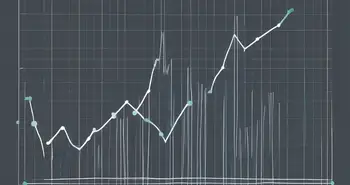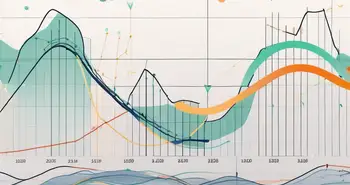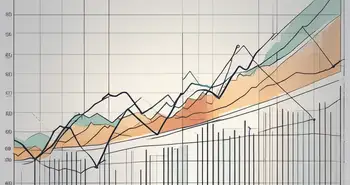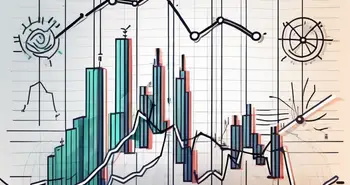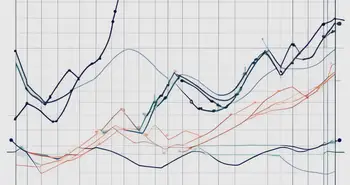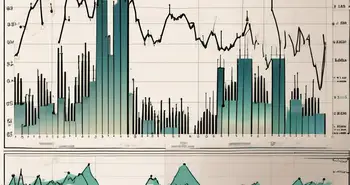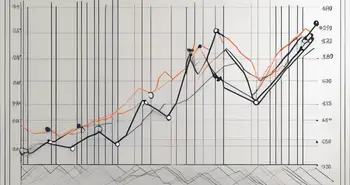Article Contents
An In-Depth Introduction to Exponential Moving Average

As an experienced trader, I can't emphasize enough the importance of mastering the art of technical analysis. One of the most effective tools in a trader's arsenal is the Exponential Moving Average (EMA). In this comprehensive guide, I will take you through everything you need to know about harnessing the power of EMA and how it can significantly enhance your trading decisions.
Understanding the Basics of Exponential Moving Average
Before we dive into the intricacies, let's begin by understanding what exactly an Exponential Moving Average is. An EMA is a type of moving average that assigns more weight to recent data points, making it more responsive to price changes. Unlike the Simple Moving Average (SMA), where each data point carries equal weight, the EMA captures the latest market dynamics more effectively.
What is Exponential Moving Average?
The Exponential Moving Average is a statistical calculation that smoothes out price data over a specified period. By giving more importance to recent prices and gradually decreasing the significance of older data, the EMA adapts swiftly to changes in market conditions.
For example, let's say you are analyzing the stock prices of a particular company over the past 10 days. The EMA calculation would assign more weight to the most recent prices, such as the prices from the last few days, and gradually decrease the weight of older prices. This allows the EMA to reflect the current market sentiment more accurately.
EMA is widely used in technical analysis to identify trends, generate trading signals, and determine support and resistance levels. Traders and investors rely on EMA to make informed decisions based on the most up-to-date market information.
Key Components of Exponential Moving Average
When using EMA, there are three crucial components to consider: the period, the smoothing factor, and the initial value. The period represents the number of data points included in the average. The smoothing factor determines the rate at which the weights decrease for each subsequent data point. Lastly, the initial value sets the starting point for the calculation.
The period can vary depending on the trader's preference and the time frame being analyzed. Shorter periods, such as 10 or 20, are commonly used for short-term trading, while longer periods, such as 50 or 200, are often used for long-term analysis.
The smoothing factor, also known as the smoothing constant or alpha, determines the rate at which the weights decrease. A higher smoothing factor places more emphasis on recent data points, making the EMA more responsive to price changes. Conversely, a lower smoothing factor gives more weight to older data, resulting in a smoother and less reactive EMA.
The initial value sets the starting point for the EMA calculation. It is typically the first data point in the series or a predetermined value chosen by the trader. The initial value helps establish the baseline for subsequent calculations and influences the overall shape of the EMA curve.
The Difference Between Simple and Exponential Moving Averages
It's vital to understand the distinction between the Simple Moving Average (SMA) and the Exponential Moving Average (EMA). While both moving averages serve a similar purpose of smoothing out price data, the EMA is more responsive to recent price changes. This increased sensitivity makes the EMA a preferred choice for traders seeking timely and accurate signals.
The SMA calculates the average of a specified number of data points by simply summing them up and dividing by the period. Each data point carries equal weight, regardless of its recency. As a result, the SMA provides a smoother representation of the overall trend but may lag behind significant price movements.
In contrast, the EMA assigns more weight to recent data points, making it more reactive to price changes. This responsiveness allows the EMA to capture short-term trends and generate signals faster than the SMA. However, the EMA may also be more susceptible to noise and false signals, especially in volatile markets.
Traders often use a combination of SMA and EMA to gain a comprehensive view of the market. The SMA helps identify long-term trends, while the EMA provides insights into short-term price movements. By analyzing both moving averages together, traders can make more informed decisions and improve their overall trading strategies.
The Mathematical Formula Behind Exponential Moving Average
Now, let's explore the mathematical formula that underpins the calculation of the Exponential Moving Average.
The Exponential Moving Average (EMA) is a widely used technical indicator in financial analysis. It is a type of moving average that gives more weight to recent data points, making it more responsive to price changes compared to other moving averages.
Calculating the Exponential Moving Average
To calculate the EMA, you need to apply the following formula:
EMA = (Close – EMA(previous day)) × (Smoothing factor) + EMA(previous day)
This calculation involves tracking the EMA values for each trading period, starting with the initial value, and applying the formula to continuously update the EMA values. The smoothing factor determines the rate at which the weights decrease for each subsequent data point.
The EMA formula takes into account the closing price of the current period, the EMA value from the previous day, and the smoothing factor. By incorporating the previous EMA value, the formula ensures that the EMA calculation is a recursive process, where each new EMA value depends on the previous one.
Understanding Weighted Multipliers
The smoothing factor, also known as a weighted multiplier, determines the weight given to the most recent data point. This multiplier ranges between 0 and 1, with higher values indicating a faster response to price changes. Traders can adjust this multiplier to suit their preferred level of responsiveness and trading strategy.
For example, a smoothing factor of 0.2 would give more weight to the most recent data point, making the EMA more sensitive to recent price movements. On the other hand, a smoothing factor of 0.1 would give less weight to the most recent data point, resulting in a smoother EMA line that is less responsive to short-term fluctuations.
Choosing the appropriate smoothing factor depends on various factors, including the time frame of analysis, the volatility of the underlying asset, and the trader's risk tolerance. Traders who focus on short-term trading may prefer a smaller smoothing factor to capture quick price changes, while those with a longer-term perspective may opt for a larger smoothing factor to filter out short-term noise.
It's worth noting that the EMA is just one of many technical indicators used by traders and analysts to make informed trading decisions. It is often used in conjunction with other indicators and tools to form a comprehensive trading strategy.
The Significance of Exponential Moving Average in Trading
Now that we have grasped the basics of EMA, let's explore why it holds such a significant position in trading strategies.
How Exponential Moving Average Influences Trading Decisions
The EMA plays a crucial role in identifying trends, providing trade signals, and evaluating market strength. It helps traders to gauge the direction and strength of price movements, enabling them to make more informed decisions.
The Role of Exponential Moving Average in Trend Identification
One of the primary applications of EMA is trend identification. By plotting multiple EMAs with different periods on a chart, traders can spot trend reversals, confirm the prevailing trend, and take appropriate action.
Strategies for Using Exponential Moving Average
Now that we understand the significance of EMA, let's explore some effective strategies for using this powerful tool.
Combining Exponential Moving Average with Other Indicators
EMA can complement other technical indicators such as the Relative Strength Index (RSI) or Moving Average Convergence Divergence (MACD) to generate more robust trading signals. For example, a bullish crossover between the EMA and MACD can signal a potential entry point for a long trade.
Setting Up Exponential Moving Average for Different Time Frames
Traders can adjust the period of the EMA according to the time frame they are trading in. Shorter periods, such as 10 or 20, are commonly used for intraday trading, while longer periods, such as 50 or 200, are preferred for longer-term analysis. Experimentation and backtesting can help find the optimal EMA periods for specific markets and time frames.
Potential Pitfalls and Limitations of Exponential Moving Average
While the EMA is a powerful tool, it's important to acknowledge its limitations and be aware of potential pitfalls.
Understanding False Signals
EMA calculations heavily rely on recent price data, which makes it sensitive to short-term fluctuations. This sensitivity can lead to false signals, where the EMA generates a signal that doesn't align with the overall market trend. To mitigate this risk, it's crucial to corroborate EMA signals with other technical indicators or use multiple EMAs with varying periods.
The Impact of Market Volatility on Exponential Moving Average
During periods of high market volatility, EMA signals can become less reliable as rapid price swings can trigger false buy or sell signals. It's important to exercise caution and adapt your strategy accordingly when market conditions become excessively volatile.
As an expert in trading, I can recall a personal experience that showcases the power of EMA. A few years ago, I was closely monitoring a stock that had been in a downward trend for several weeks. However, the EMA started to flatten out, indicating a potential trend reversal. By combining the EMA signals with other technical indicators, I confidently entered a long position. Within days, the stock reversed its trend, resulting in a substantial profit.
FAQ
What is an Exponential Moving Average?
An Exponential Moving Average (EMA) is a type of moving average that assigns more weight to recent data points, making it more responsive to price changes.
How does EMA differ from the Simple Moving Average (SMA)?
While both moving averages serve a similar purpose of smoothing out price data, the EMA is more responsive to recent price changes compared to the SMA.
What is the significance of EMA in trading?
The EMA plays a crucial role in identifying trends, providing trade signals, and evaluating market strength. It helps traders to gauge the direction and strength of price movements, enabling them to make more informed decisions.
How can I effectively use EMA in my trading strategy?
EMA can be effectively used by combining it with other technical indicators, such as the Relative Strength Index (RSI) or Moving Average Convergence Divergence (MACD), and adjusting the EMA period to suit the trading time frame.
What are the potential limitations of EMA?
EMA calculations can generate false signals and can be less reliable during periods of high market volatility. It's important to corroborate EMA signals with other technical indicators and adapt your strategy during volatile market conditions.
Now armed with this comprehensive guide to the power of Exponential Moving Average, you can incorporate this versatile tool into your trading strategy and take your market analysis to the next level. Remember, practice and experimentation are key to mastering the art of technical analysis, so start exploring the potential of EMA in your trading today!
Ready to put your newfound knowledge of Exponential Moving Averages to the test? Join Morpher today and experience a trading platform that's as innovative as your strategies. With zero fees, infinite liquidity, and the ability to trade a multitude of assets including stocks, crypto, and more, Morpher is the perfect place to apply your technical analysis skills. Plus, get started with a free sign-up bonus to kick off your trading journey. Sign Up and Get Your Free Sign Up Bonus and be part of the future of investing with Morpher.

Disclaimer: All investments involve risk, and the past performance of a security, industry, sector, market, financial product, trading strategy, or individual’s trading does not guarantee future results or returns. Investors are fully responsible for any investment decisions they make. Such decisions should be based solely on an evaluation of their financial circumstances, investment objectives, risk tolerance, and liquidity needs. This post does not constitute investment advice.

Painless trading for everyone
Hundreds of markets all in one place - Apple, Bitcoin, Gold, Watches, NFTs, Sneakers and so much more.

Painless trading for everyone
Hundreds of markets all in one place - Apple, Bitcoin, Gold, Watches, NFTs, Sneakers and so much more.


